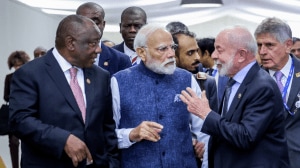How the past helps forecast the future
How the monsoon is forecast and how an upcoming project is expected to make predictions more accurate
What is forecast,and when?
Every year,the India Meteorological Department comes out with a long-range forecast of monsoon rains for the country as a whole in the four-month season from June to September. The first forecast comes in the third week of April with only the overall prediction announced. In the second or third week of May,the IMD announces the monsoon onset date (normal June 1) at the Kerala coast. Towards the end of June,the Met department updates its April forecast,giving also a region-wise and month-wise break-up of expected rainfall.
How is the arrival of the monsoon declared?
The Met department assesses the conditions for the monsoons arrival in Kerala,then predicts an onset date. It studies weather patterns in the Asia-Pacific region,compares these with historical data,and then makes a prediction based on previous occasions when similar conditions prevailed. For this,historical data of at least 30 years is necessary. This is called the statistical model of forecasting. Since 2005,the India Meteorological Department has been using an indigenously developed statistical model that has provided correct forecasts so far.
Once the monsoon has arrived,how is its advance predicted?
The Met department now works with patterns actually observed. It makes short-range forecasts (for 3-10 days) from dynamical models; this involves a lot of computing. For long-range forecasts for the country as a whole,it follows a statistical model as forecasts from dynamical models have not been accurate enough.
How reliable is the model used?
The statistical model may have been forecasting the monsoon onset accurately but its ability to forecast the monsoon rainfall is limited. It often fails to predict the extreme drought and flood years. It has provided useful forecasts for monthly and seasonal rainfall over the country as a whole,and for seasonal rainfall over four geographical regions: Northwest India,Central India,Northeast India and South Peninsula. But it needs to be developed so that it can accurately forecast the rainfall over smaller regions such as state,subdivision,district. Such forecasts will be vital for agricultural planning in India.
What improvements are planned?
The Ministry of Earth Sciences is tying up with the US for Monsoon Mission,a project aimed at developing a more accurate system. Shailesh Nayak,Ministry secretary,is optimistic it will be in place within five years.
What will the prediction model be like?
It will be different from the one in use. The Monsoon Mission will work with a combination of ocean-atmosphere physics and known mathematical equations.
How will the partnership work?
A monsoon desk will be set up in the US. Its members will coordinate with Indian scientists and help them with know-how. A coordinator at the US National Centre for Environmental Prediction (NCEP) will be in constant touch with Indian scientists.








- 01
- 02
- 03
- 04
- 05























